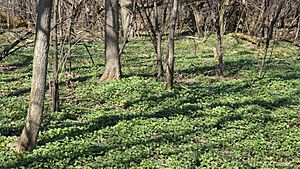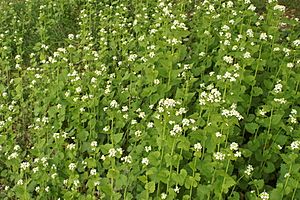Garlic mustard as an invasive species facts for kids
Garlic mustard (Alliaria petiolata) is a plant that was brought to North America from Europe in the 1860s. People thought it would be a good herb for cooking. But it quickly became an invasive species, meaning it spreads fast and harms native plants. Today, you can find it in most parts of Eastern United States and Canada. It's even listed as a harmful plant in many states.
Scientists are trying to find ways to control it. One idea is to use a special kind of bug, a weevil called Ceutorhynchus scrobicollis, that only eats garlic mustard. But getting approval to release this weevil has been difficult.
Contents
Why Garlic Mustard Spreads So Easily
Like many invasive plants, garlic mustard can grow and spread quickly in new places. In many areas of Eastern North America, it has become the main plant growing on the forest floor. This makes it very hard to get rid of.
In its home country, many insects and fungi eat garlic mustard. But these natural enemies are not found in North America. This means the plant can produce many more seeds. It also means it can easily out-compete native plants for space and resources.
Garlic mustard also harms some native insects. For example, it is toxic to certain North American butterflies, like the Pieris virginiensis and Pieris oleracea.
How Garlic Mustard Harms Other Plants
Garlic mustard makes special chemicals called allelochemicals. These chemicals stop important fungi from growing in the soil. Most native plants, including forest trees, need these fungi to grow well. But the chemicals don't hurt the fungi from garlic mustard's native home. This "secret weapon" helps garlic mustard succeed in North America.
Also, white-tailed deer usually don't eat garlic mustard. When there are many deer, they eat other native plants. This leaves more space for garlic mustard to grow. Deer walking through the forest can also disturb the soil. This helps garlic mustard seeds sprout and grow.
Garlic mustard seeds can stay alive in the soil for at least five years, and possibly longer. Because of this long-lasting seed bank and its harm to helpful fungi, it's hard to restore areas where garlic mustard has invaded. You need to remove it for a long time to get rid of the seeds and let the fungi recover.
Garlic mustard also produces other compounds that make it less tasty to animals that might eat plants. In some forests, garlic mustard leaves break down faster than native leaves. This adds more nutrients to the soil, which can help garlic mustard spread even more.
Controlling Garlic Mustard
The best way to get rid of garlic mustard is to stop it from making seeds. You also need to empty the "seed bank" in the soil. But seeds can last for up to twelve years, and just one plant can make thousands of seeds! Animals, vehicles, and people can easily spread these seeds around.
Mechanical Control Methods
You can remove garlic mustard without chemicals or special bugs. This includes pulling plants by hand, cutting them at the base, mowing, or burning them. You can also try to change the environment to reduce light, but garlic mustard can grow in deep shade.
Pulling plants by hand works best if you remove the whole root. Try not to step on or compact the soil around other plants. Garlic mustard can grow in both stable forests and disturbed areas. It can also grow in many different moisture levels.
It's best to control garlic mustard in early spring before it flowers. The plants are smaller then, so pulling them causes less soil disturbance. This also gives other plants more time to grow. However, it's easy to miss small plants. They can flower even if they are only a few inches tall. The flowers make them easier to see, especially in dim light.
Sometimes, roots will break off when you pull them, especially in compacted or dry soil. These root pieces can regrow. Mowing and cutting are also more effective before the plants flower. This is because cut pieces are less likely to have enough energy to bloom and make seeds.
You should bag and properly dispose of removed plants, or burn them. Seeds or roots might survive composting. Pulled plants can still bloom and make seeds, especially if their roots are still attached, even as the plant is dying.
Chemical Control Methods
You can use chemicals called herbicides to control garlic mustard. You spray these on the leaves. Herbicides work better in places that are already disturbed, like gardens or farms. They are harder to use in complex places like forests.
Spraying herbicides in early spring might help protect native plants. This is because garlic mustard usually starts growing earlier than most other plants in cooler climates. This early growth is one reason it can out-compete and replace native plants. However, some native plants are active even earlier or at the same time in early spring. Some native plants are also evergreen, meaning they are always vulnerable to herbicides.
Chemical control methods that use heavy equipment or involve people walking around can compact the soil. This harms all plants. These methods can also disturb wildlife. Chemical solutions might cause water pollution through runoff.
All non-biological control methods need to be repeated for 2 to 5 years to work well. This is because many invaded areas have a large seed bank in the soil. Seeds can keep sprouting for over ten years. Surviving roots can also regrow and make new seed pods. This means the plant can quickly come back. Garlic mustard can also be easily reintroduced to areas where it was removed. This is because its long-lived seeds are made in large amounts and spread easily by animals and people.
Biological Control Methods
Biological control is a method that uses living things to control pests. It is usually the least harmful to natural areas like forests. It can also be the most cost-effective. For some invasive plants, or in some cases with garlic mustard, using herbicides or human labor like mowing or pulling might be better for disturbed land, like farms. But even then, biological control agents can help.
For more complex places like forests, biological control can reduce or remove problems like soil compaction, spreading seeds from clothes, chemical harm, and the need for lots of human labor. For example, one type of weevil that targets garlic mustard eats its seeds. Unlike some invasive plants that live only one year, garlic mustard can regrow from its tap root. This is especially true if it's mowed in its second year when the root has stored a lot of energy.
Scientists prefer to use "monophagous" controllers. These are species, like the weevil Ceutorhynchus scrobicollis, that only eat one type of plant, in this case, garlic mustard. This greatly reduces the chance that the introduced controller will become a pest itself.
One challenge with biological control is finding species that are safe to introduce. Another challenge is that fewer controlling species might be present in the new ecosystem. In its native environment, 76 different things feed on garlic mustard. But in the United States, almost nothing eats it enough to make a difference. Even with so many natural enemies, experts believe that introducing just two weevils, with C. scrobicollis being the most important, could control garlic mustard in the United States.
The example of garlic mustard shows how effective even one monophagous biological control agent can be. It also shows how it can be the least costly method. However, bringing in and releasing biological control agents like these can be stopped by strict research and regulation rules. Some people argue these rules are needed to prevent the agents from becoming new pests. Others argue that the rules make it too hard to use these better methods, forcing people to use more damaging and costly methods like spraying herbicides in forests.
As of May 2017, there is no legally approved biological control agent to fight garlic mustard in the United States. Scientists have been studying garlic mustard in the United States since the 1990s. The weevil C. scrobicollis has been studied specifically since 2002. In 2012, scientists recommended releasing it into the US, but a group called TAG blocked it. They asked for more research. Even though this research was completed, the petitions to release the weevil have continued to be blocked.



